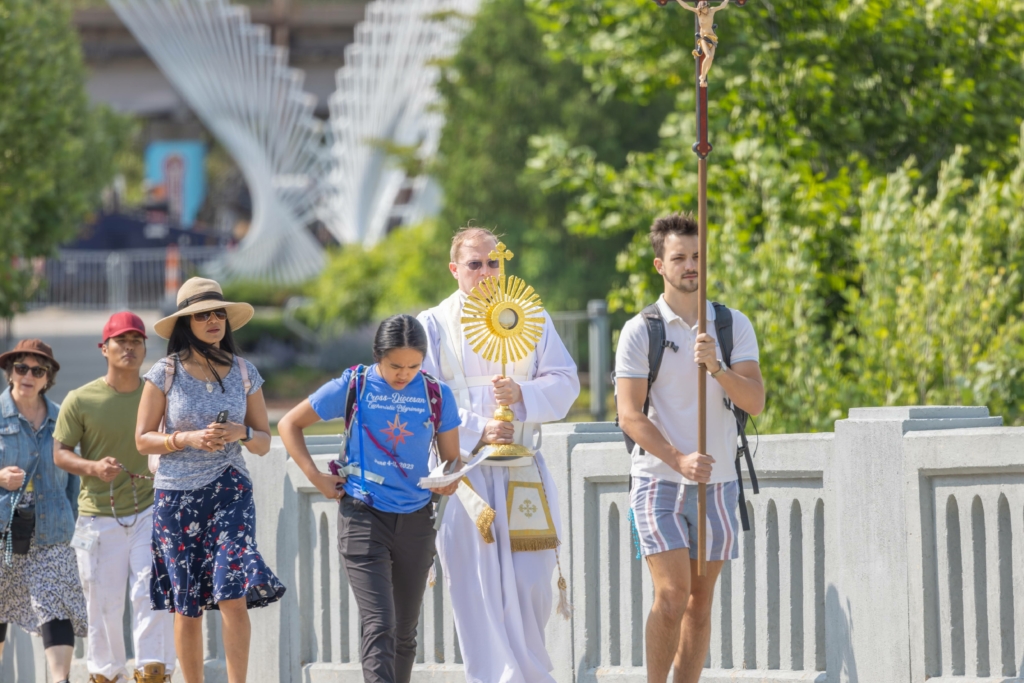CV NEWS FEED // Nobody knew her name. Nobody even talked to her.
The only thing the five perpetual pilgrims learned about the woman in the red Jeep was that she had a powerful encounter with the Eucharist.
It was day four of their eight-day, 100-mile Eucharistic procession. The five perpetual pilgrims and eleven local pilgrims had not seen a car for some time as they processed along an isolated Indiana county road. Ahead of them, they saw a red Jeep speeding toward them. The Jeep slowed down. And then it stopped. The driver never said a word, but just stared at the procession.
As the Eucharist passed in front of the car, she made the sign of the cross, and a look of peace fell across her face. And she sat there until the procession was out of sight. None of the pilgrims know how the procession impacted her, but perpetual pilgrim John Donahue knows that the National Eucharistic Pilgrimage to take place next year will have many more stories just as moving as this one.
“When I first heard about the 100-mile pilgrimage, I thought it was unattainable,” said Donahue. “But I learned that it is possible and that this is critical to evangelization as it is going to impact a lot of people, especially those that may be fallen-away Catholics.”
Donahue was one of five perpetual pilgrims who made a Eucharistic procession from Fort Wayne to South Bend, Indiana. He was joined by Will Peterson, the Executive Director of Modern Catholic Pilgrims; Lauren Rivera, an undergraduate at Notre Dame; Bridget Breckler, a young woman who plans to enter a Carmelite monastery in the fall; and Fr. Stephen Felicichia, a former military soldier who now serves as a priest for the Diocese of Fort Wayne-South Bend.
The “practice” pilgrimage was organized by Peterson’s company to work out the kinks for next year’s National Eucharistic Pilgrimage.
“The pilot program showed us that the procession raises questions for people,” said Peterson in an interview with CatholicVote. “They cannot avoid it because we are coming into the public space and we are just present right there where people are.”
Next summer, Modern Catholic Pilgrim will help organize four pilgrimages that will cross the country as part of the National Eucharistic Revival. Routes will start in San Francisco, California; Hartford, Connecticut; Lake Itasca, Minnesota; and Brownsville, Texas. All will convene in Indianapolis, Indiana, for the National Eucharistic Congress, July 17–21.
One priest and 12 perpetual pilgrims will walk with the Eucharist along the entire route, stopping at parishes for the night before continuing on their journey each day.

But four separate pilgrimages could be a logistical nightmare if not properly planned for.
“We want to make sure that we are taking care of our pilgrims and that they have safety on the road,” said Peterson. “We are blessed to have a point person in each diocese to help us coordinate the logistics; it helps to have those boots-on-the-ground people who really know the local Church.”
Modern Catholic Pilgrim has worked for the past year to lay the groundwork for the four pilgrimages, contacting dioceses, finding sponsors, and consulting with the United States Conference of Catholic Bishops (USCCB).
Two major concerns have arisen in the past year that the group has sought to address: the pilgrims’ physical safety, and maintaining liturgical reverence.
Due to the pilgrimage’s sheer length, many liturgical customs normally practiced in solemn processions cannot be used. Modern Catholic Pilgrim has consulted with multiple liturgical advisors as well as the USCCB’s Office for Divine Worship.
Every day, the pilgrims will attend Mass at the parish where they are staying. Then, the congregation will be invited to join the pilgrims on a one-mile solemn procession with a canopy, servers, and incense. The solemn procession will conclude at a temporary altar. After a brief ceremony, the perpetual pilgrims will proceed in a simple procession, escorted by a crucifix bearer, the monstrance, and a support vehicle. Bystanders will be invited to join them on that day’s 15-20-mile journey.
“The perpetual pilgrims will be like stewards of the pilgrimage; they will help facilitate others’ experiences,” said Peterson. “People will get to literally walk with Christ, which is so great!”

Modern Catholic Pilgrim has already talked to local law enforcement agencies along the various routes and discussed with diocese coordinators the potential safety hazards: traffic, isolated areas, and opposition from protesters who could turn violent. When traversing through especially dangerous areas, the perpetual pilgrims will ask all other participants to stay home so that they can safely process with the Eucharist.
During the pilot pilgrimage, the pilgrims came across a few protesters who shouted at the group, leading to some tense situations.
“We want to do our darndest to make sure that Christ will be present in these places of suffering,” said Peterson. “We want him to be in these areas of pain, suffering, and violence, but we will do it in a safe manner.”
“We encountered three or four people that were unhappy with us,” said Donahue. “I knew that the best course of action when this happens is to not engage with the person and to just keep walking.”
To address this and other issues, Peterson is planning on hosting multiple online training sessions for the perpetual pilgrims and potentially an in-person retreat. These sessions are also intended to provide the pilgrims with resources on how to talk to passersby about the Eucharist and explain the procession’s purpose.
All of this planning is meant to help Catholics across the United States have their own ‘Emmaus Moment’, a moment of encounter and sending forth on mission.
“Bishop Cozzens has a vision for the Eucharistic Revival that aligns closely with this idea that these pilgrimages are to walk with Christ just as they did on the road to Emmaus and to recognize Him in the Breaking of the Bread,” said Peterson.

While the pilgrimage will touch the lives of thousands across the United States, perhaps the most impacted will be the pilgrims themselves. For two months, they will live and walk in a community, forming deep bonds. The five pilgrims that traversed across Indiana formed deep friendships over the course of eight days; they are already planning a reunion in September.
“Our group is already planning a reunion because we really enjoyed each other’s presence and went through this unique thing together,” said Donahue.
The National Pilgrimage will conclude with the National Eucharistic Congress, the capstone to the USCCB’s three-year Eucharistic Revival. Currently, the Revival is in the year of parish revival, which seeks to foster encounter and evangelization through parish-based events. Already, leaders are seeing the fruits of the revival at work within parishes.
“This past year, which was about engaging leaders, we’ve seen the Church wrestling to adopt and engage with this vision and are beginning to truly see the buds of Eucharistic revival. Thousands of parishes and schools are now directly mobilized into this movement,” said Tim Glemkowski, Executive Director of the National Eucharistic Congress, in an email to CatholicVote. “My prayer is that God is not anywhere close to done as we move into the Parish Year, reaching those in the pews, and the Year of Mission—going out with the life-changing message of the Gospel and inviting the world to the beauty of the Catholic faith.”

The post Community, Reverence and Safety: The Planning Behind Four Cross-Country Pilgrimages appeared first on CatholicVote org.
- Exposed: Abortion Conference Identified Catholic Church as Major ‘Obstacle’ - November 13, 2023
- DC Crime Update: Secret Service Agent with Biden Grandchild Opens Fire at Carjacker - November 13, 2023
- Analysis: The Difference School Choice Would Make in Texas - November 13, 2023
JOIN US @NewRightNetwork on our Telegram, Twitter, Facebook Page and Groups, and other social media for instant news updates!
New Right Network depends on your support as a patriot-ran American news network. Donate now



